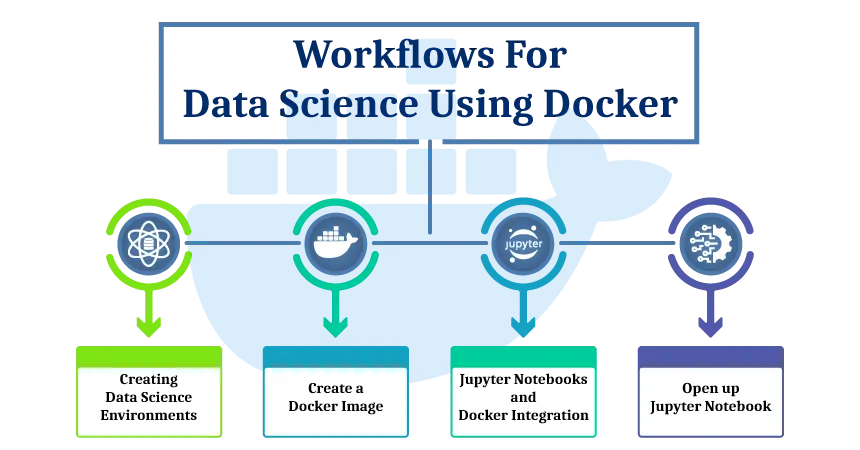Introduction
The popular open-source platform Docker makes application development, deployment, and administration easier. It packages apps and their dependencies using containerization technology to ensure consistent behaviour across many settings. This solves the "works on my machine" issue, enabling faster application deployment and simpler team collaboration. There is no denying that Docker is a crucial part of machine learning development. But why is Docker for data scientist so helpful? The excitement around Docker is not unfounded. Scientists can advance faster because they have a stable setting for experimentation. The workflow for data scientists to get you towards production is now easy for data engineers. In this blog, we will explain how you can apply Docker to data science and how it can make your machine-learning workflow more efficient.
What is Docker?
To create, distribute, and run programmes, developers have traditionally used Docker. Data engineers and data scientists embraced Docker faster, which was first used in 2013 for software development. Programmers and engineers with data science backgrounds are familiar with Docker and have used it to build, deploy, and operate ML models. How does Docker achieve this? All the dependencies, frameworks, tools, and libraries required to run your project are there in a single environment for convenience. It is scalable, stackable, and portable. This implies that you can duplicate it, share it with others, and create services on top of it. What else might a data scientist need? Once you complete a Data Science Certification Program, you can explore many ways to handle data.
Why Do Data Scientists Use Docker?
Data scientists now have a potent tool in the form of Docker to help them build reproducible environments. They can ensure consistency across several platforms, and make collaboration easier. You can share your work, deploy models, and uphold reproducibility by encasing your projects in Docker containers.
If you have done any course like IIT Data Science, you can start using Docker for the below benefits:
- Reproducibility
Docker allows for the encapsulation of a full environment, including dependencies, libraries, and configurations. By doing this, you can ensure that your code functions on a range of devices and operating systems. This makes it simpler to repeat your experiments and distribute your work to others.
- Collaboration
A standardised environment is made available through Docker containers, making it simple to share with coworkers. By sharing a Docker image, you may collaborate on projects without having to worry about by hand setting up dependencies.
- Streamlined Deployment
The consistent environment that Docker offers across many deployment platforms streamlines the deployment of data science models. To make it simple to deploy on cloud platforms, edge devices, or even in production environments, you can package your model with its dependencies as a Docker container.
- Scalable and Portable
Docker containers are portable, light, and scalable up or down as required. In various situations, such as on-premises servers, cloud platforms, or edge devices, this makes it simpler to deploy your models or apps.
- Consistency
Consistent environment management is possible with Docker. It enables you to create and control a reliable environment for your data science initiatives. You can prevent conflicts and guarantee reliable outcomes. Specify only the precise versions of software packages and libraries required for your work.
- Put Models Into Production
Once your model is finished, you can package it up into an API. Now put it in a Docker container to be sent to DevOps for deployment. Better yet, you can deploy your machine learning model using Kubernetes without the need for DevOps. Even though it is possible to deploy without Docker, many data scientists like using Docker for slicker, more dependable deployments. It also increases portability for future use of the deployment.
- Supports GPU Acceleration
You can use GPU acceleration with Docker to make use of the processing power of GPUs for deep learning frameworks like TensorFlow or PyTorch. Use the proper base images, and set up your Docker environment to make use of the GPU.
Workflows For Data Science Using Docker

1. Creating Data Science Environments
A Dockerfile that lists the necessary programmes, libraries, and dependencies. They are made to develop a data science environment using Docker. If you have done a Data Science Course, then you might be aware of the crucial environment.
2. Create a Docker Image
This code instructs the command line to create a Docker Image using a Dockerfile located in the current directory.
3. Jupyter Notebooks and Docker Integration
For interactive computing and data exploration, Jupyter Notebooks are a well-liked tool among data scientists. You may create a reproducible environment for your work by integrating Docker with Jupyter Notebooks. If you want to operate a Jupyter Notebook server within a Docker Container, you can alter the Dockerfile. It should include the appropriate Jupyter components and expose the necessary port. You can upload your Docker Images to a container registry like Docker Hub or Google Container Registry will allow you to share them. Others can then take your image and use it as the basis for their projects or right away deploy it to their environment. Join an online Data Science Course To know more about the tools and languages suitable for data science.
4. Open up Jupyter Notebook
Run the following command to launch a Docker container with the Jupyter Notebook server:
docker run -it -p 8888:8888 my-datascience-image
When you run this command, Docker builds a new container from the "my-datascience-image" and launches it. The host machine's browser can be used to access Jupyter Lab since the container translates port 8888 from the container to port 8888 of the host system and starts JupyterLab (as defined in the Dockerfile).
Our Learners Also Read: 15 Most Popular Data Science Tools With What Is Unique About Them?
Docker Images And Secrets
You should not keep secrets into your Docker images, like it is bad practice to put secrets into a Git repository. Repositories are there to store and distribute images. It is logical to assume that whatever you use to create a picture could one day become public. You should not save any sensitive information there, including your username, password, API token, key code, or TLS certificates.
There are two circumstances where secrets and docker images coexist:
- When building, you need a secret.
- At runtime, you need a secret.
You cannot resolve either issue by incorporating anything into the image. IIT Data Science Course
Conclusion
Dockers helps by supplying uniform, reproducible environments. By giving streamlining cooperation, Docker provides data scientists with several advantages. You may simplify your projects and guarantee accurate findings by utilising Docker for your data science procedures. When using virtual machines, Docker leverages containerization. They enable many containers to share the same OS kernel, making them more lightweight and resource-effective. Because each container runs on its own, behaviour is maintained across many settings. Join the IIT Guwahati data science course, to learn more about such tools and techniques.


